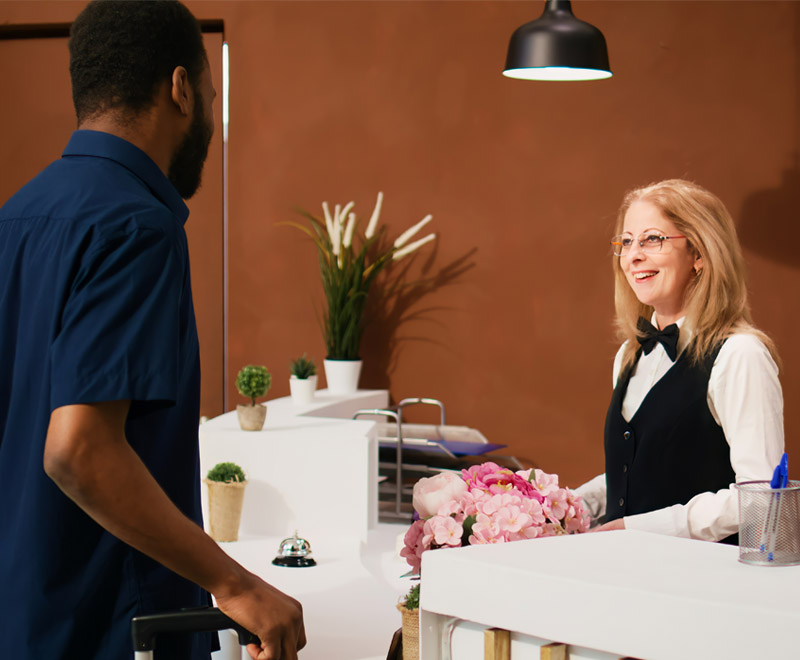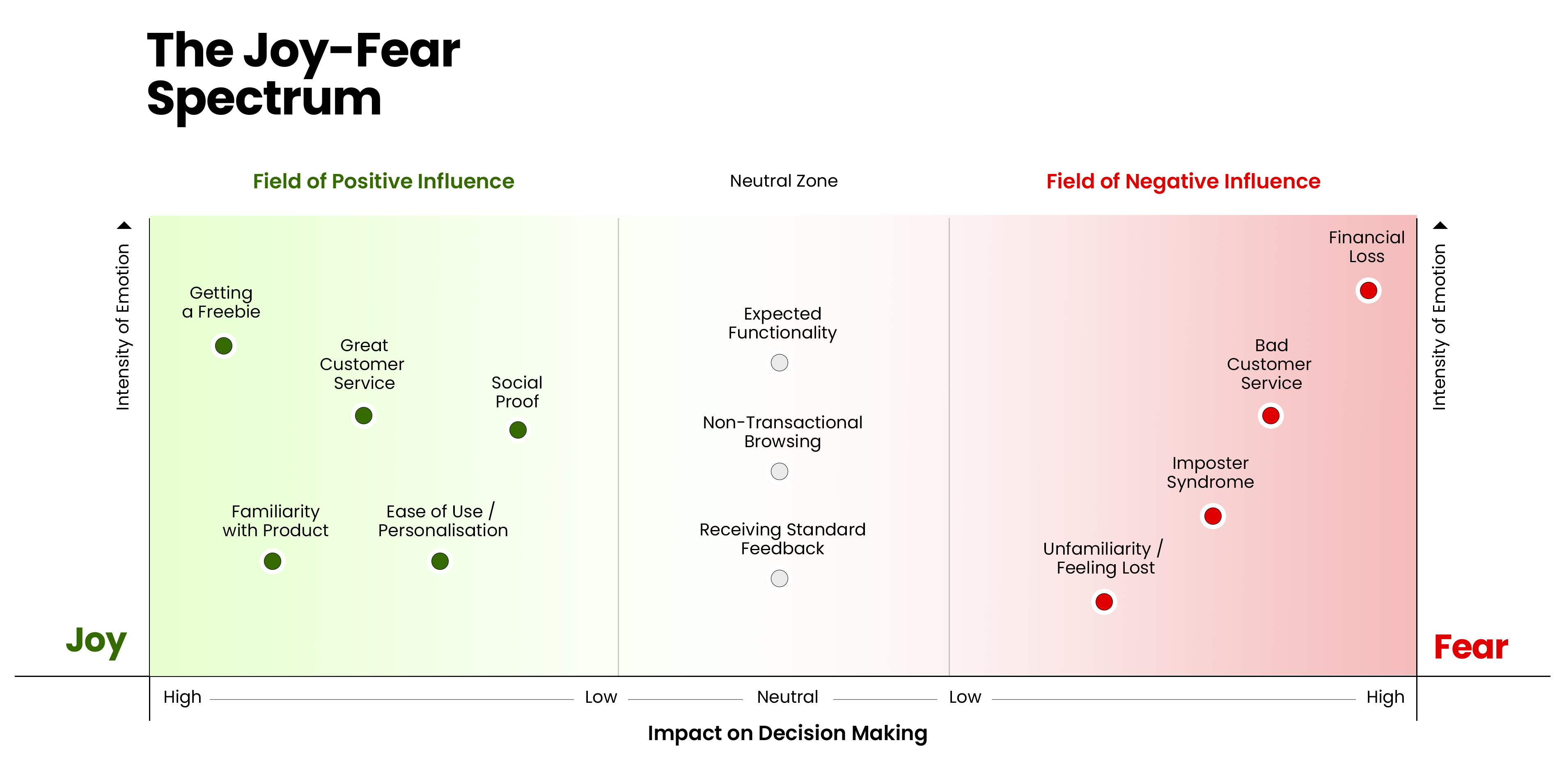

FFor quite some time, I've been ‘unofficially’ using this approach in my work, but the more I used it the more I started to realise the broad applicability of this approach as a framework. I call it the Joy-Fear Spectrum and it’s based around the idea that our behaviours, actions and how we make decisions is intrinsically associated with the emotional reaction that they trigger.
As the name suggests, in this model these two emotions—joy and fear—sit on opposite ends of a spectrum, and they shape how we interact with everything around us. From the products we use to the brands we engage with, these emotions influence our decisions, our satisfaction, and ultimately, whether we stick around or move on.

"The Joy-Fear Spectrum is based around the idea that our behaviours, actions and how we make decisions is intrinsically associated with the emotional reaction that they trigger."
Now, I’m certainly not suggesting that considering emotions as decision drivers in an entirely novel idea. We have the great Don Norman’s entire Emotional Design theory to lean on, which breaks down user responses into visceral, behavioural, and reflective levels. In addition, Plutchik’s Wheel of Emotions, which categorises emotions into pairs—like joy-sadness and fear-anger also have some interesting parallels with my thinking.
Having said that, I believe that the Joy-Fear Spectrum takes this idea further and as with some of the other frameworks I have developed in that past (7D, PACE, Model-X etc.) JFS is a practical and actionable approach to solving real-world challenges. What I’ve come to realise is that these emotional drivers—joy and fear—operate at and influence our decisions at a near-subconscious level, much like our fight-or-flight response. And as designers, it’s our job to guide users away from the barriers that fear creates and towards the moments of delight that keep them coming back.
I created the Joy-Fear Spectrum as a framework that can help us better understand, design for, and ultimately influence user behaviour in more meaningful ways.
If you’ve been following my writings or have heard me speak of late, then you would’ve heard me talk about the significance of designing for behaviours over designing for needs. Traditionally, many of us have been taught to focus on solving users’ problems. Find the pain point, address it, and the job is done, right? My opinion on this is simply that while solving problems is important, it's inherently limited. It keeps us focused on the present and often forces us into a reactive "fix-the-basics" mindset.
"By focusing on user behaviours rather than just needs, we begin to understand why people do what they do—not just what they do. And at the heart of those behaviours lie two powerful influencers: joy and fear."

The reality is that people don’t always use products simply because they’re functional or efficient. They engage with experiences because of the emotional impact those experiences have on them. This is why some products create lasting loyalty (or repeat usage to say the least) and others get abandoned the moment something better comes along.
By focusing on user behaviours rather than just needs, we begin to understand why people do what they do—not just what they do. And at the heart of those behaviours lie two powerful influencers: joy and fear.
As I mentioned earlier, the way I think about it is by seeing joy and fear as two ends of a line. Joy, on one end, is the positive emotional outcome users seek—those delightful, surprising, and memorable moments that keep them coming back. Think of those free freshly baked cookies at DoubleTree check-in or those extra fries at the bottom of the Five Guys take away bag! (yes, food brings me joy!) In each of these cases, the logical part of my brain knows that I am paying for those ‘extras’ through the price of the item I have purchased, but the sense of ‘in-the-moment’ joy supersedes the rational.
Fear, on the other end, represents the barriers—whether it’s the fear of failure, frustration, being disliked or simply feeling lost that stop people from fully engaging with a new brand or product.

"If we want to create memorable experiences - those that foster loyalty and deep engagement - we need to help users ‘shift-left’ towards the joyful end of the spectrum."
The reason I see this as a spectrum is because most experiences don't reside at either extreme. They fall somewhere in the middle, where things are functional, expected, or routine. However, if we want to create memorable experiences—those that foster loyalty and deep engagement—we need to help users ‘shift-left’ towards the joyful end of the spectrum. And this means addressing the fears that hold them back.
Have a look at the following visual representation of the Joy-Fear Spectrum. It illustrates a number of key concepts that make up this framework, and I’ll go through them next.

Joy and the Field of Positive Influence
This makes up the left half of the spectrum. Joy being a key emotion that drives our behaviour, has its own gravitational pull or as I refer to it, its Field of Influence. The further higher-up you are on the left of the spectrum the more intense the feeling of joy and the more influence it would have on a person to want to experience that again, hence repeat engagement or loyalty to the product or experience. Experiences within the field of influence of Joy tend to evoke emotions like satisfaction, delight, and confidence etc.
Fear and the Field of Negative Influence
The opposite of Joy in this case is Fear, which makes the right half of the spectrum. Similar to Joy, the further top-right you go within the Field of Negative Influence, the more intense the feelings become and the bigger the barrier it is for a person to overcome. The uncomfortable or negative emotions associated with the right-hand side are those of anxiety, frustration, social judgement or potential financial loss.
Neutral Zone
Further afield from both intense feelings of Joy and Fear is the central Neutral Zone. This part of the spectrum covers experiences that are neither particularly joyful nor fearful—these interactions meet expectations but don’t evoke strong emotions. These experiences tend to be more transactional with limited to no emotional influence. Things like receiving a confirmation email when you place an online order or a polite hello at the check-in desk – these are expected features and experiences that don’t evoke a strong emotional response, but they are expected to be present, nonetheless.
When we talk about designing for joy, we’re really talking about creating those standout moments that leave a lasting impression on users. Joy isn’t about flashy features or gimmicks—it’s about making real, authentic connections that feel effortless and personal. Think of Apple’s approach: there’s joy in the simplicity of their design, the seamless interaction between devices, and the thoughtful details that just work—like how AirPods magically connect to your phone without a second thought. It’s not just about functionality; it’s about delight.
But while joy keeps users coming back, fear is what holds them back in the first place. And by fear, I don’t mean panic—more like hesitation, frustration, or uncertainty. These are the barriers that stop people from fully engaging with your product or service. Consider the financial sector, where fear of complexity often keeps users from diving in. Companies like Monzo and Stripe break down those barriers by making financial data and services simple and clear, easing anxieties and empowering users to take action.
The key is this: to design truly impactful experiences, we need to not only build moments of joy but also remove the fear that keeps users from getting there. Whether it’s Nike’s personalised shoe designs, which create joy by tapping into individual creativity, or Amazon’s hassle-free returns policy, which calms the fear of making the wrong purchase, the goal is the same. By reducing friction and making people feel understood, we move them away from fear and towards experiences they’ll remember—and return to.
So, how can we, as designers, apply this model? The key lies in mapping the emotional journey users go through when interacting with a product or service. Most experience designers should be familiar with the idea of mapping journeys and customer empathy so the base skills required to use the framework should already be there. However, rather than just focusing on functional needs, we need to anticipate and map where users might encounter fear and proactively design ways to alleviate it.
Here are a few ways to apply the Joy-Fear framework in practice:
1. Identify Fear Triggers:
Start by identifying where fear or anxiety might be creeping into the user experience. This could be during onboarding, at key decision points, or when users are faced with unfamiliar features. Once identified, you can work on ways to reduce these barriers—whether through clearer instructions, more intuitive design, or offering reassuring customer support.
2. Create Moments of Delight:
While eliminating fear is important, it’s equally essential to create moments of joy. These moments don’t have to be big; often, it’s the little things that leave a lasting impression. Personalisation, thoughtful interactions, or an unexpected but meaningful surprise can elevate a user’s experience and leave them with a positive emotional memory.
3. Test for Emotional Impact:
When testing your designs, don’t just focus on usability or efficiency. Pay attention to the emotional responses of your users. Ask them and observe how the experience made them feel. Did they encounter any moments of frustration or anxiety? Were there any features that made them smile or feel empowered? Use this feedback to fine-tune the experience and shift users further along the spectrum towards joy.
At its heart, the Joy-Fear Spectrum is a human-centric framework designed to map and drive engagement by understanding the emotional forces at play. This framework doesn’t just apply to designing new customer experiences, if the objective is to understand and enhance engagement by any group of people, then in principle the Joy-Fear Spectrum should add meaningful value. So, whether we’re focusing on customers, internal teams or even for one’s personal career development, JFS should help us better navigate the drivers and barriers that influence the final outcome. After all, decisions aren’t purely logical; they’re emotional too, and this spectrum helps us navigate that reality.
I’ve included a few examples below of how various teams might be able to utilise the framework to develop human-centric value.
Product Management Teams:
If you’re a product manager, this framework will help you understand why users stick around or walk away. It’s all about identifying those joyful moments that keep them coming back for more and fixing the fear-inducing barriers—like confusing pricing or clunky onboarding that make them second-guess their choices. By smoothing the path, you’ll build products that people love using, not just tolerate.
Marketing and Communications Teams:
Marketers can use the spectrum to craft campaigns that connect with people where it matters - emotionally. It’s not just about showing features and benefits but addressing what makes people hesitate (like fear of wasting money or time) while also showcasing what excites them (like solving a problem in a way they didn’t expect). When you get the emotional side right, your messaging becomes a lot more powerful.
Customer Support Teams:
Customer service is where joy and fear collide most often. When a customer is having an issue that’s already dipping them into the fear zone. But if you can quickly resolve the problem and offer a little extra kindness or efficiency, you’ve helped them shift back towards joy. This framework gives support teams a way to track those moments and turn potentially negative experiences into positive ones.
Sales Teams:
Sales are all about managing emotions. Calming fears and amplifying excitement. By understanding where a potential customer is emotionally, you can adjust your approach. Maybe they’re worried about cost, so you reduce that fear with a clear ROI explanation. Or maybe they’re already curious and excited, in which case you focus on making them feel like they’re getting something truly special.
Employee Engagement and HR Teams:
Inside the organisation, HR teams can apply the Joy-Fear Spectrum to boost employee engagement. Whether its helping staff overcome fears like job insecurity or burnout, or fostering joy through recognition and growth opportunities, this model provides a clear way to improve the work experience, building a more loyal, motivated team.
Career Development and Personal Growth:
Even on a personal level, this model helps individuals make better career decisions. Mapping out the things that bring joy (like challenging projects or a good work-life balance) versus the things that create fear (like stagnation or lack of feedback) helps people steer their careers in a direction that brings lasting satisfaction.
At its core, the Joy-Fear Spectrum is an engagement model designed to better understand human motivation and decision drivers. By recognising that emotions—both positive and negative—are fundamental drivers of behaviour, we can create more meaningful, memorable experiences that go beyond solving problems. Whether you’re designing a new product, refining a service, or crafting an entire brand experience, the key is to guide users away from fear and towards joy.
And when you do, you create something that’s not just functional, but something that resonates on a deeper, emotional level—something that people want to come back to again and again.
Usman is a digital veteran and a renowned expert in human-centric innovation and product design. As the founder of Pathfinders, Usman works directly with businesses to uncover disruptive opportunities and helps create tangible business value through design and innovation.
Book an initial consultation with Usman »